Maturation process: Michael Bunting's NHL opportunity is a product of finally, fully committing to professional habits
Welcome to the AZ Coyotes Insider newsletter. My plan is to publish stories four to six times per week. By subscribing, you’ll be supporting independent, accountable journalism. Subscribe now so you won’t miss a story.
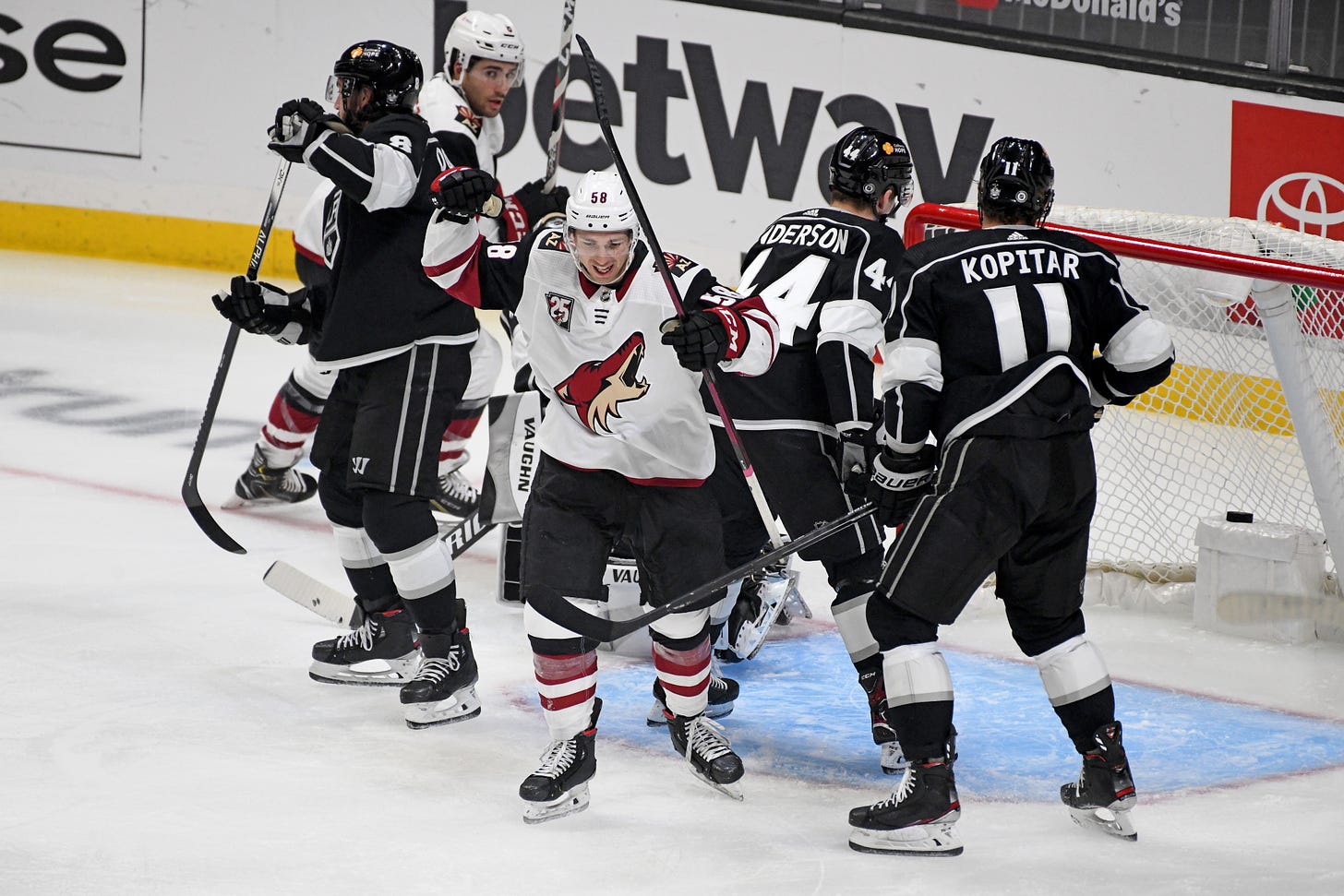
Rapid ascents are nothing new for Michael Bunting. He played just about every sport at Cardinal Newman Catholic High School in Scarborough, Ontario; from volleyball, badminton and tennis, to soccer and hockey.
It wasn’t until his senior year that he played his first season of Triple-A hockey with the Don Mills Flyers.
“It’s expensive to play hockey in Toronto,” said Bunting, who worked out a payment plan with the Flyers to help his parents afford it (a fairly common occurrence in Triple-A hockey). “I was definitely good enough but I enjoyed going to high school every day. I was a regular kid until Grade 12.”
Bunting had never considered a professional hockey career, but once he was named the MVP of a Triple-A All-Star game late that season, he started getting calls from junior teams and Sault Ste. Marie Greyhounds GM Kyle Dubas (now with the Toronto Maple Leafs) drafted him with the first pick in the ninth round of the 2013 OHL Priority Selection.
“I was sitting down at the dinner table one week with my mom and we were talking about what college I should go to and what I wanted to do with my life,” he said. “The next week, it was interviews with OHL teams and then playing junior hockey.”
The eight-year anniversary of that draft popped up on Bunting’s Facebook memories on Tuesday. It was appropriate timing considering what he had just accomplished the previous night in his ninth career NHL game and the fourth since his call-up from Tucson this season. Bunting’s first NHL hat trick (Arizona’s fourth this season) helped the Coyotes open a five-point lead in the race for the West Division’s final playoff spot with a 5-2 win against the Kings in Los Angeles.
Like Roadrunners teammate Conor Garland did two seasons earlier, Bunting has burst onto the scene with four goals and five points since arriving on March 31. Unlike those two watershed moments, however, Bunting’s ascent to the NHL has been anything but rapid.
Bunting is the only remaining Coyotes farmhand who played for the franchise’s AHL affiliate while it was still in Springfield. He has logged more AHL games (323) than any Coyotes draft pick still in Arizona’s system.
Bunting’s offensive skills were always visible in Tucson. He had 23 goals in 67 games in 2017-18, and he had seven goals in 16 games before his call-up this season, but there were critical elements missing from the profile of a pro player; elements that his coaches saw for five AHL seasons, but Bunting neglected to address until this past summer.
“I had heard mixed reviews about his professionalism and then (assistant coach) Jay (Varady) told me what a difference he saw in him this season,” Coyotes coach Rick Tocchet said. “(Roadrunners coach) Steve Potvin said the same thing and so did (Tucson assistant) John Slaney. It was almost like an awakening, like he realized, ‘This is what I have to do to be a pro.’”
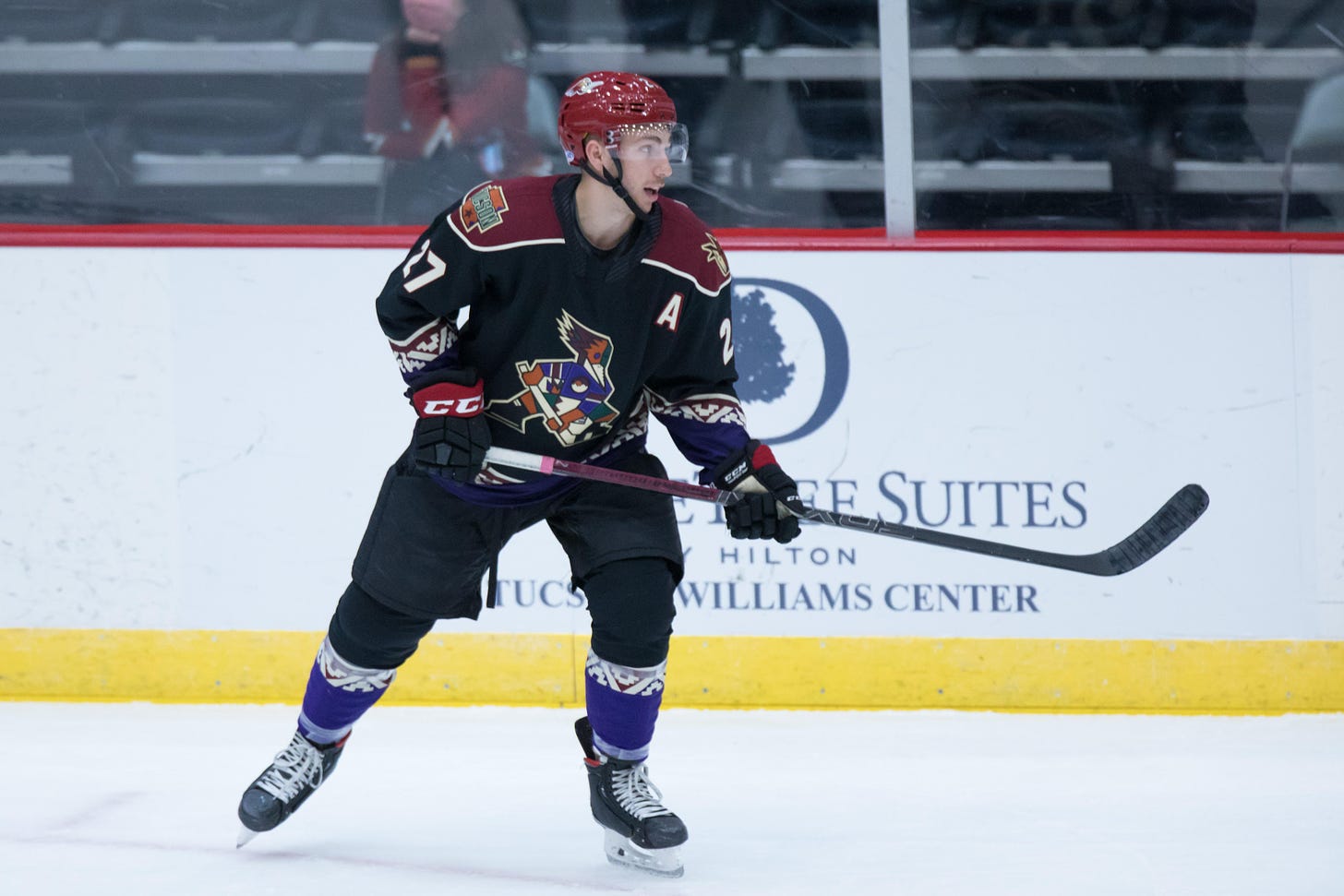
Maybe it was simply the maturity that comes with age. Maybe it was the realization that time was running out on his chances of cracking an NHL lineup, but Bunting, 25, took advantage of the 11 months he had between Tucson’s last game in the COVID-shortened 2019-20 season, and the Roadrunners’ first game this season.
He devoted more time to cardio workouts than he ever had in the past. He shed seven pounds to improve his overall fitness, his speed, and his ability to sustain energy on extended shifts. He worked diligently to implement every bit of minutiae that Potvin threw his way.
“He was a guy that used to really value rest as a weapon,” Potvin said. “His mindset wasn't always to dedicate himself to practice to achieve that 1 percent improvement every day. As successful as he was, there were still a lot of habits that needed to grow.
“This summer, you could really see he had intent in his workouts, intent in his practices and not just intent, but intensity. When we asked him to skate through lines, he skated through lines. When we asked him to stop in front of the net, he stopped in front of the net. When we asked him to be defensively responsible, he was defensively responsible. He has committed to greater habits. That’s why you are so proud to see him achieve success because he was so far away on a lot of those.”
Bunting also worked to become a better 200-foot player.
“I just had to realize that all of the game is not about offense,” he said. “I was definitely a little more offense driven in the past few years. I wanted to get points and that’s how I wanted to help the team. This summer, John Slaney sent me some (penalty-killing) clips and I just worked more on my D-zone than anything.
“I knew I had the ability to put up offensive numbers in the American league and that wasn't an issue. It was more about my D-zone, some of my details and finishing checks. That’s almost more important than the offense.”
Another element of his game that Bunting needed to address was his fiery temperament.
“Part of his strength is that he’s emotional,” said Varady, who was the Roadrunners coach last season before being elevated to Coyotes assistant this season. “He’s always involved in the game but learning how to control that emotion in certain times and being able to play hard, physical, net-front hockey without taking a penalty or losing focus is something he had to harness.”
The nature of Bunting’s game means he is going to be more engaged with opponents. His game is predicated on going to the net and to the so-called dirty areas. That, in turn, leads to confrontations like his back-and-forth with Kings defenseman Drew Doughty on Monday.
“He’s comfortable there, he enjoys being there and it’s pretty natural for him,” Varady said. “At the same time, being around the fray requires emotional control, and he’s done a much better job of that.”
Bunting’s net-front poise has paid major dividends so far. Of the four NHL goals that he has scored this season, Varady joked that the farthest one probably came from 10 feet out. That goal came on a one-timer off a feed from Garland that gave the Coyotes a 1-0 lead just 2:43 into Monday’s game.
The next two goals came off rebounds of Jakob Chychrun shots from the top where Bunting kept whacking away until the puck found the back of the net.
“I got a lot of texts after the game saying, ‘That was a Michael Bunting goal’ because all of my past teammates have seen that a million times, just me cleaning up the garbage,” Bunting said, laughing. “I have a knack around the net and I do enjoy going there because that’s where chances are and that’s where goals are, but there’s a price to be paid. I had a few bruises (Tuesday) morning but I’ll take those every day to be able to score.”
In Garland’s first season in Tucson (2016-17), he and Bunting played together the entire season and built chemistry despite being “buried on the fourth line” and getting little power-play time.
Garland’s favorite Bunting memory comes from Game 1 of the Roadrunners’ second-round, 2018 playoff series against the Texas Stars at Tucson Arena.
“We’re up 1-0 and someone on their team goaded him into a penalty, kind of sold it,” Garland said. “They pushed each other and the guy flopped late in the game. They scored on the power play to tie it up and I remember between the third (period) and OT, he had his head in his hand. He was so mad at himself for taking that penalty.
“He goes out there in OT, takes a clapper from the top of the circles and scores and I don’t think he even celebrated other than a quick celly because he was still so mad at himself. You just have to laugh at that. That’s it right there. That’s Bunts.”
When Bunting was recalled last month, Garland observed a trend in Bunting’s game during a two-game sweep of the Ducks.
“I tried to talk to him (Monday) because I noticed he was doing some of the same stuff that I did that I thought was good, but it’s not,” Garland said. “In Anaheim, he was almost just trying to get the puck to me and (Nick Schmaltz) and I was like, ‘Listen, you’re up here for a good reason. You’re a good player. Don’t just defer to other guys. Play your game.’
“I did that when I got called up. Any time I got moved up the lineup I would defer to (Clayton Keller) and Schmaltzy or (Derek Stepan) when I played with him and then I would have really good games playing on the fourth line because I played my game.”
Bunting said the advice helped him to relax.
“This is the best league in the world and you’re playing with exceptional players so you almost want to give them the puck all the time,” he said. “But those two have told me to play my game, carry the puck, and make my own plays.
“Playing on a line with G helps, too, because I’m comfortable playing with him. I’m not always worried that I have to give him the puck or give Schmaltzy the puck. Those two have really helped my transition into this league.”
Nobody expects a hat trick, but Garland isn’t surprised by Bunting’s early success with the Coyotes.
“He is someone that you could always tell believed in himself,” Garland said. “He could have been 28 and doing this and I still wouldn’t be surprised.”
Tocchet has been searching for players who will willingly and consistently go to the net, so he admits that when he witnesses Bunting’s recurring forays, “There’s nothing that makes me smile more.” The challenge for Bunting, Tocchet said, is doing it on a consistent basis to cement a place in the lineup.
After working and waiting so long for his opportunity, Bunting has no plans to change his most endearing habit.
“Every hockey player has had that moment when you’re in the American league and you’re in a dry spell or the road trip is long and you’re wondering, ‘Is it ever going to happen?’” he said. “It’s pretty easy to get negative. When I did, I would reach out to people that I could talk to. That helped the most when I was feeling down on myself. I’d do that, let it out and I was good to go again.
“It has been a long road and I have definitely had some doubts along the way, but I always believed in myself. I can't thank my coaches in Tucson enough. They kept me going, kept me positive, and they just kept believing in me.”
Follow Craig Morgan on Twitter: @CraigSMorgan





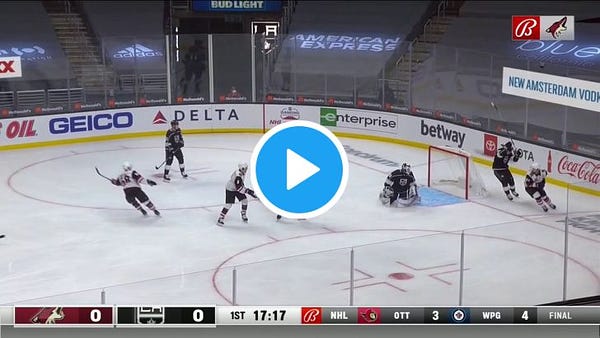
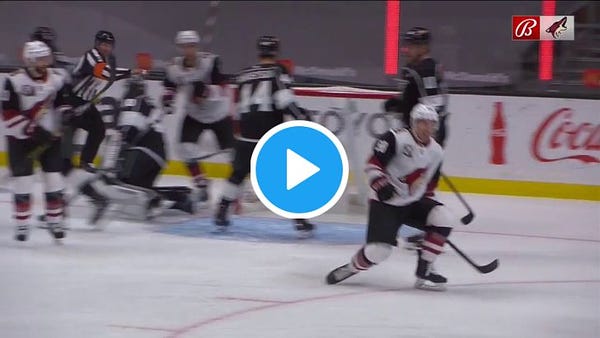
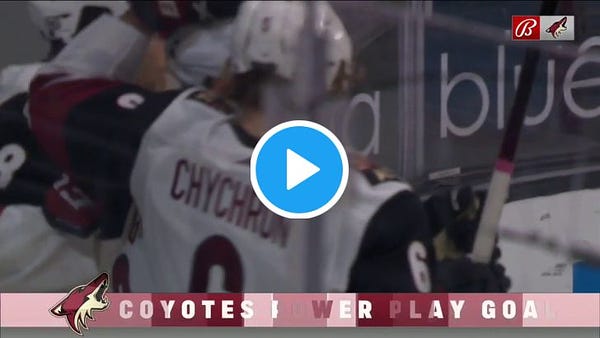

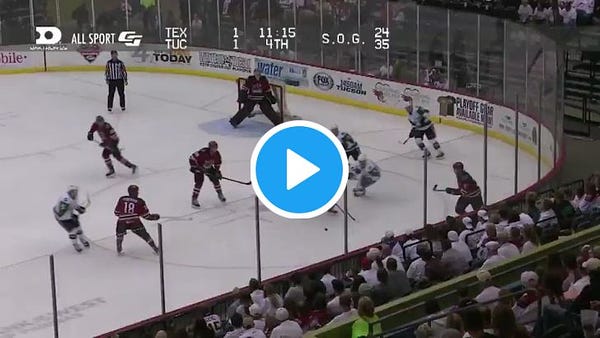
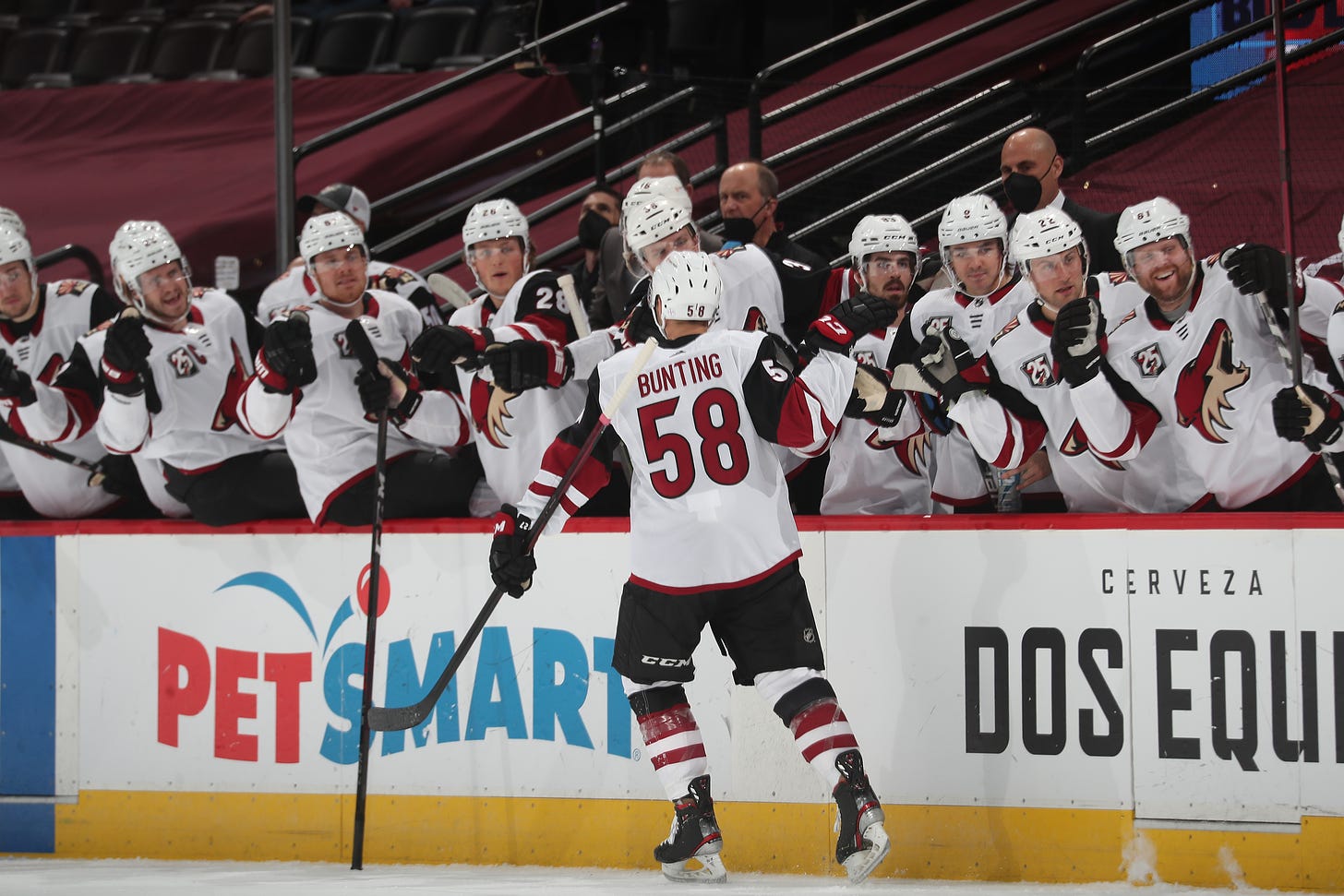

Somebody in front of the net that can be a little nasty?
Yes, please!
Hard to believe this guy was drafted by Don Maloney SEVEN years ago.